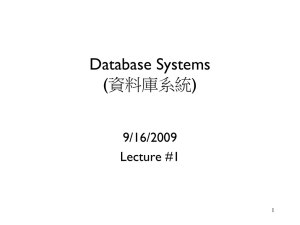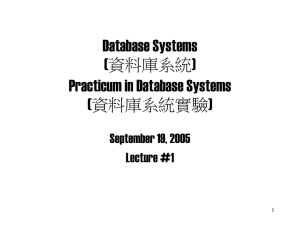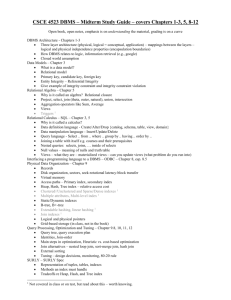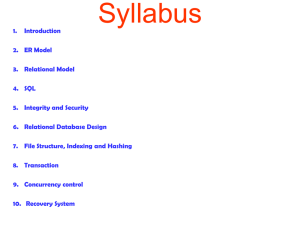Introduction
advertisement
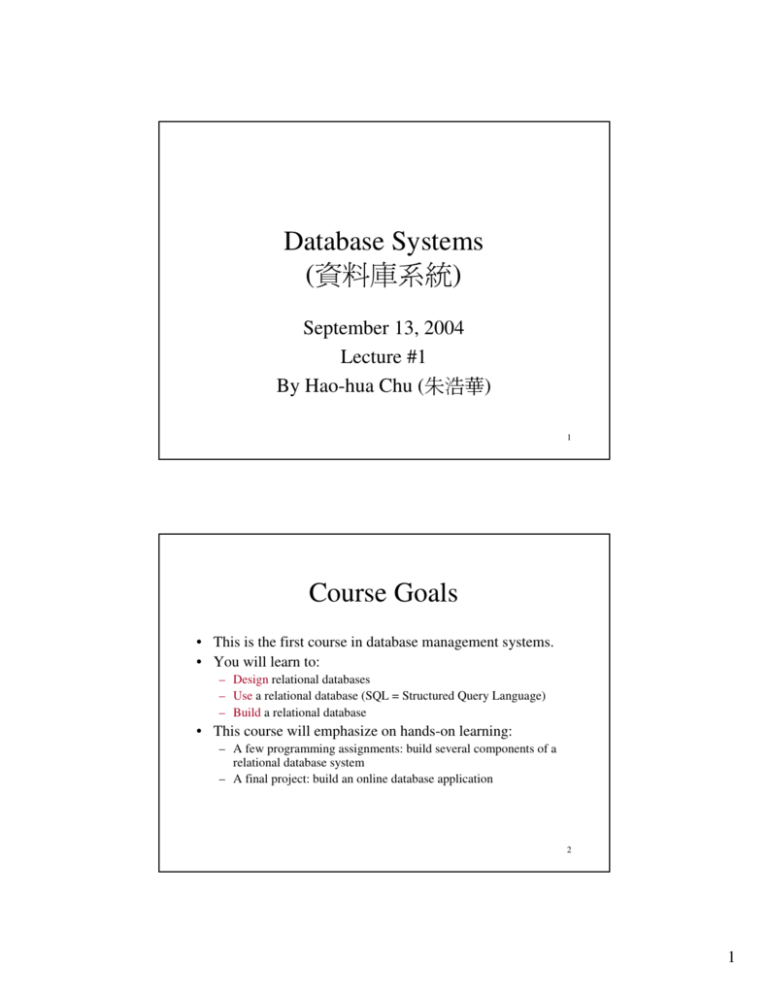
Database Systems ( ) September 13, 2004 Lecture #1 By Hao-hua Chu ( ) 1 Course Goals • This is the first course in database management systems. • You will learn to: – Design relational databases – Use a relational database (SQL = Structured Query Language) – Build a relational database • This course will emphasize on hands-on learning: – A few programming assignments: build several components of a relational database system – A final project: build an online database application 2 1 Prerequisite • Data structure and algorithms • Good at C++ programming – You will do considerable amount of coding in C++. – If you don’t know C++, you need to learn it on your own. • English skill – This course is taught in English (except some TA sessions may be in Chinese). – If I speak too fast, please tell me to slow down. – You can ask questions in English or Chinese. 3 Administrative Details 4 2 Textbook • Required textbook: “Database Management Systems, Third Edition”, by Ramakrishnan and Gehrke. • The textbook is available from and (and perhaps other) bookstores. • Other good textbooks on Database Systems: – "Database System Concepts" by Silberschatz, Korth, and Sudarsan – “Database Systems: The Complete Book”, by Garcia-Molina, Ullman, and Widom 5 Course Format • Lecture (2:20 ~ 3:40, 80 minutes), break (3:40 ~ 4:00, 20 minutes), and lecture (4:00 ~ 5:20, 80 minutes). • Programming Assignments – SQL on Microsoft Access – Major database components (work in teams of 2 students) • Exercises – Textbook • Midterm and Final Exams 6 3 Grading Breakdown (Tentative) • • • • Tentative means that I may change it later. Programming Assignments & Exercises (50% of Grade) Midterm Exam (25% of Grade) Final Exam (25% of Grade) 7 Office Hours (Tentative) and Contact Info • Instructor: Hao-hua Chu ( ) – Mon 10:00~11:00, Room 527 or by appointment – Email: hchu@csie.ntu.edu.tw • Teaching Assistant #1: John Huang, – Wed 13:00~14:00 & Thur 14:30~15:30, Lab 217 – Email: yfhuang@csie.ntu.edu.tw • Teaching Assistant #2, KengHao Chang, – Tues 13:00~14:00 & Fri 13:00~14:00, Room 336 – Email: kenghao@gmail.com 8 4 Means of Communications • Course homepage (working now) – http://mll.csie.ntu.edu.tw/course/database/index.html – Please check it daily for announcements • BBS – – – – – ptt.cc, under “CSIE_DBMS” board Please post your questions on BBS. Please read posted messages before posting new questions. Do not SPAM, you should post questions related to this course ONLY. TAs will try to respond to your questions as quickly as possible. • Send email to TAs or me. • Come to office hours 9 Lecture Notes • I will try to put lecture notes on the course homepage shortly before each lecture. • Lecture notes are complements, not replacement of attending lecture and reading textbook. – Attend lectures. – Read assigned chapters in the textbook. 10 5 Student Evaluation of Database Course last year 11 • If I don’t explain materials clearly enough, please interrupt me right away! 12 6 • “Course load is too heavy” – This is average course load in top computer science departments. • “Lack of midterm exam” – We will have a midterm exam this semester. • “English teaching” – This is requested from the department & NTU university. • “Teaching staff copying programming assignments from abroad” – The programming assignments come with the book. 13 14 7 Academic Integrity • We detected many assignments with code plagiarism in the last year’s course. – Receive 0 grade for the assignment + Penalty! • You are supposed to write your own code: every single line (except skeleton TAs give you). • You are not allowed to – – – – – copy any code from other groups let other groups copy your code. see other groups’ code. show other groups your code. copy any code from the Internet & senior class (don’t even try them, because we have them!) 15 Any Question(s) on Administrative Things? 16 8 Talk about an interesting project in Ubiquitous Computing (Won’t be Tested) 17 KY:iyashikei-net (Urico Fujii, Ann Poochareon, NYU) & communicating Tears 18 9 Chapter 1: Overview of Database Systems 19 Outline • • • • • • • • Why do we need a DBMS (Database Management System)? What can a DBMS do for an application? Why study database systems? Data Models: Overview of a Relational Model Levels of Abstraction in a DBMS Sample Queries in DBMS Transaction Management Overview Structure of a DBMS 20 10 Motivation for Database Systems • Suppose that you want to build an university database. It must store the following information: – – – – – – – Students Professors Classes Classrooms Who teaches what? Who teaches where? Who teaches whom? 21 Application Requirements • Store huge amount of data (e.g., 100+ GB) over a long period of time • Allow people to query and update data – Query: what is Mary’s grade in the “Operating System” course? – Update: enroll Mary in the “Database” course • Protect from unauthorized access. – Students cannot change their course grades. • Protect from system crashes – When some system components fail (hard drive, network, etc.), database can be restored to a good state. 22 11 More Application Requirements • Protect from incorrect inputs – A student cannot enroll in two courses with the same lecture times. • Support many users to access the database at the same time – 100 students are using database to register courses at the same time. • Allow administrators to easily change data schema – At a later time, add TA info to courses. • Efficient database operations – Search for students with 5 highest GPAs 23 Alternative to Using a DBMS • Store data as files in operating systems. • Applications have to deal with the following issues: – 32-bit addressing (5GB) is insufficient to address 100GB+ data file – Write special code to support different queries – Write special code to protect data from multiple users and concurrent access – Write special code to protect against data loss / corruption as result of system crashes – Password-based authorization is insufficient – Rewrite applications when data schema changes – Optimize applications for efficient access and query • Easier to buy a DBMS to handle these issues 24 12 Database Management System (DBMS) • DBMS is software to store and manage data, so applications don’t have to worry about them. Applications • What can a DBMS do for applications? • Query language – Storage management – Transaction Management System (DBMS) – Data Definition Language - DDL – Data Manipulation Language - DML Abstraction & Interface (Database language: SQL) • Concurrency control • Crash recovery Perform dirty work that you don’t want applications to do – Provide good security, efficiency, and scalability 25 Why Study Database Systems? • $$$ • They are used everywhere to store and manage data. This means $$$ for people with DB knowledge. – – – – – Online stores, real stores Banks, credit card companies Police (criminal records), Passport control Airlines and hotels (reservations) University, etc. • DBMS vendors can make a lot of $$$: – Oracle, Microsoft (Access and SQL server), IBM (DB2), Sybase, … 26 13 Data Models • A data model is a collection of concepts for describing data. – Entity-relation (ER) model – Relational model (main focus of this course) • A schema is a description of a particular collection of data in a given data model. • The relational model is the most widely used data model today. – – Main concept: relation, basically a table with rows and columns of records. Every relation has a schema, which describes the columns, or fields. 27 Relational Model • The entire table shows an instance of the Students relation. • The Students schema is the column heads – Students(Sid: String, Name: String, Login: String, age: Integer,… ) sid name login age gpa 53666 Jones Jones@cs 18 3.4 53688 Smith Smith@ee 18 3.2 53650 Joe Joe@cs 19 2.5 28 14 Levels of Abstractions in DBMS • Many views, one conceptual (logical) schema and one physical schema. – Conceptual schema defines logical structure – Physical schema describes the file and indexing used • • – Relation tables Sorted file with B+ tree index App1 App2 View 1 View 2 View 3 Conceptual Schema Physical Schema Views describe how applications (users) see the data • Relation tables but not store explicitly 29 Example: University Database • Conceptual schema: – – – Students(sid: string, name: string, login: string, age: integer, gpa:real) Courses(cid: string, cname:string, credits:integer) Enrolled(sid:string, cid:string, grade:string) • Physical schema: – – Relations stored as unordered files. Index on first column of Students. App1 View 1 App2 View 2 View 3 Conceptual Schema Physical Schema • External Schema (View): – Course_info(cid:string, enrollment:integer) 30 15 Data Independence • Three levels of abstraction App1 App2 provides data independence. • This is one of the most important View 1 View 2 View 3 benefits of using DBMS. • Applications insulated from how data is structured and stored. Conceptual Schema – Logical data independence means that when conceptual schema is changed, no need to change apps. – Physical data independence means that when physical schema is changed, also no need to change apps. Physical Schema 31 Queries in DBMS • Sample queries on university database: – What is the name of the student with student ID 123456? – What is the average salary of professors who teach CSIE courses? – How many students are enrolled in database course? • The key benefits of using a relational database are – Easy to specify queries using a query language: Structured Query Language (SQL) SELECT S.name FROM Students S WHERE S.sid = 123456 – Efficient query processor to get answer 32 16 Transaction Management • A transaction is an execution of a user program in a DBMS. • Transaction management deals with two things: – Concurrent execution of transactions – Incomplete transactions and system crashes 33 Concurrency Control • Example: two travel agents (A, B) are trying to book one remaining airline seat (two transactions), only one transaction can succeed in booking. // num_seats is 1 Transactions A and B: if num_seats > 0, book the seat & num_seat--; // overbook! • Solution: use locking protocol Transaction A: get exclusive lock on num_seats Transaction B: wait until A releases lock on num_seats Transaction A: if num_seats > 0, book & num_seat--; // book the seat, num_seat is set to 0 Transaction A: release exclusive lock on num_seats Transaction B: num_seats = 0, no booking; // does not book the seat 34 17 Crash Recovery • Example: a bank transaction transfers $100 from account A to account B A = A - $100 <system crashes> B = B + $100 // good for the bank! • Solution: use logging, meaning that all write operations are recorded in a log on a stable storage. A = A - $100 // recorded A value (checkpoint) in a log <system crashes> // start recovery: read the log from disk A = A - $100 B = B + $100 35 Structure of a DBMS • A typical DBMS has a layered architecture. • The figure does not show the concurrency control and crash recovery components. • This is one of several possible architectures; each system has its own variations. Applications Queries These layers must consider concurrency control and crash recovery Query Optimization and Execution Relational Operators Files and Access Methods Buffer Management Disk Space Management 36 18 Summary of Chapter 1 • DBMS is used to maintain and query large datasets. • Benefits include recovery from system crashes, concurrent access, quick application development, data integrity and security. • Levels of abstraction give data independence. • A DBMS typically has a layered architecture. 37 Homework • Read Chapters 1 (Today) • Read Chapters 2 (except 2.7) & 3 38 19 Feedbacks from Students • How much can you understand from lecture? – – – – <25% 50%+ 75%+ 100% • How is the speed of my talk? – Too fast? – Too slow? – About right? 39 20


